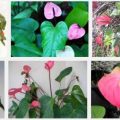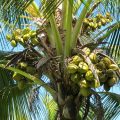Orchids Production Guide
Introduction
The Orchid Family – The Family Orchidaceae consists of about 20,000 to 35,000 species distributed in 800 genera which constitutes 10% of all flowering plants. Approximately more than 1,000 hybrids and cultivated forms are continuously produced per year. Many endemic species are found in the Philippines. There are about 130 genera and 941 species. Around 25 genera and 104 species are of commercial value. Many of the endemic species have contributed significant roles in the orchid hybridization work in various countries. Among them are Vanda sanderana or “waling-waling”, v. merrillii, v. lamellate, v. lyzonica, aerides lawrenceae, a. jarchiana, phalaenopsis amabilis, p. lueddemanniana, p. pulchra, renanthera storei, r. philippinensis, dendrobium taurinum among many others.

General Species/Hybrids
Dendrobium – the genus Dendrobium contains a very large number of heterogeneous species. They have an erect, cane-type pseudo bulb and have flowers with relatively long vase life. They are naturally distributed in the warm and humid areas with an elevation of 0-500 m above sea level. In the Philippines, the Dendrobium group includes d. taurinum, d. stratioles, d. superbeins, d. phalaenopsis, d. biggibum and others. Some Dendrobium hybrids which are promising for cutflower production in the Philippines classified according to flower color are the following:
Purple – D. Jacquelyn Concert, D. Norma Jackson, D. Garnet Beauty and D. Uniwai Prince
Pink – D. University of Hawaii Crosses, D. Tomie, D. Sonia, D. Jacquelyn Thomas, D. Cesar, D. Waipaho Beallty.
White with Red Hip – D. Bangkok Fancy, D. Youpadeewan, D. Palolo Beauty
White – D. Singapore White, D. Walter Oumae, D. Jacquelyn Thomas, D. Multico White, D. University of Hawaii #306, D. Madame Vipar, D. Clomen White.
Yellow – D. May Mak, D. Betty Ho “Kamiya”, D. Kasem Gold, D. Jiad Gold
Vanda – the members of this group are generally sun loving and robust with a wide range of colorful, beautiful shaped flowers which are of heavy substances and long lasting.
Vandas are grouped according to leaf types, namely: strap leaf, terete leaf and semi-terete. The strap leaf vandae have flat, broad and channeled leaves like Vanda Sanderana (waling-waling). Terete vandas have cylindrical pencil like leaves like Vanda Miss Joaquin (Singapore Orchid). Semi-terete vandas have midway between terete and strap leaf vandas. Semi-terete vandas are highly floriferous.
The following hybrids are found to flower well under local condition.
V. Josephine van Brero Crosses
V. T. M. A.
V. Eman van Deventer Crosses
V. Velthius Crosses
V. Walter Gumae
V. Penang Manila
Phalaenopsis – the graceful bearing of the Phalaenopsis whether our native species or more advance hybrids is quite pleasing to the eye. The long, slender flower stalk bears the flowers high and arcs away from the leaves giving it is fragile and pleasing appearance. Some promising species are P. amabilis, P. stuartiana, P. schilleriana, P. equestris, P. lueddemaniana, P. sanderana and others.
Arachnis – Renanthera Type – Arachnis and Renanthera type flowers range from fiery red, brilliant orange, yellow brown to white. They are monopodial, terrestrial and the flowers come in long stiff sprays. They are more tolerant to full sunlight. The common hybrids for cutflowers are Arachnis Maggie Oie and Aranethera James storei.
Cattleya and its Alies – modern Cattleyas actually consists of a complex group of hybrids created by combining Cattleya species or hybridization with closely allied genera such as Laelia, Brassavola, Broughtonia ans a few others. These orchids known as the “Cattleya Alliance” are natives in Brazil, Columbia, Central America and Mexico. The genus Cattleya presents a very interesting group of orchid with broad spectrum of colors, types and more diversified.
Cultural Requirements
Basically, the growth requirements of any plant are temperature, water, light, aeration and nutrition. These are the environmental factors to which orchids will have to adapt themselves. A good grower should thus attempt to stimulate the optimum levels of these factors for each type of hybrid orchids.
Light – sun loving orchids are the Arachnis, Renanthera, Aranda and terete and semi-terete Vandas. Some Dendrobium hybrids can also tolerate full sun, but their leaves turn yellowish and sometimes lose some of their leaves. Semi-terete vandas flower profusely when exposed to full sunlight. However, they should be protected from intense heat during the hot summer months by temporarily placing one layer of fist net over the plants.
Partial shade orchids need lower intensity for healthy growth. Most of the Dendrobiums, Phalaeopsis, Cattleyas and strap leaf Vandas belong to this group. An inexpensive shade house is needed for mature Dendrobium plants to reduce light intensity by about 30% or allow 70% light transmission by installing two layers of fish net, 3-5 m high over the plants. For younger plants which require 50% to 60% sunlight, three layers of net can be used.
Orchid plants receiving enough light have short plump stems with yellowish-green leathery leaves. Those receiving too much light are yellowish, stunted and even scorched. Those under too much shade become green, soft and succulent with thin spindly stem.
Water – the need and frequency of watering should depend on several factors such as potting media, size of containers, temperature, light intensity, air movement or kind of plant.
Orchids grown in large containers dry out slower than those in pots. Plants in baskets, twigs or slabs require more water than those in pots or with coconut husk. During rainy days, plants should not be watered for days depending on the remaining moisture in pots. Because of the presence of pseudobulb in Cattleyas or Dendrobiums, the frequency of watering is much less needed than in Vandasa.
Plants grown under high wind velocity, high temperature, low relative humidity and high light intensity require more frequent watering. Plants suffering from lack of water become placid, stem or pseudobulb becomes shriveled. Beginners more often kill the plants by over watering.
Aeration – orchids must have free circulating air and high humidity around them. Stagnant air does not allow drying of potting medium and foliage. The occurrence of diseases is very minimal when there is excellent ventilation.
Temperature – the cool growing orchids like Cymbidium, Odontoglossums and some Phaphiopedilums prefer night temperature of 10°C to 18.3°C, and 15.5°C to 21°C dry temperature.
The intermediate groups such as Cattleyas, some Dendrobius, some Oncidium prefer night temperature of 12.8°C to 15°C, and 18.3°C to 21°C dry temperature. Most of the orchid grown in the Philippines are warm growing plants where night temperature is below 18.3°C and dry temperature ranging from 21°C to 32°C. these temperature rates are ideal for growing Renanthera, Vandas, Phaleonopsis, Aerids, Dendrobiums and many others.
Nutrition – the amount and kind of fertilizer required by orchids depend on the growing conditions, potting media, species and stage of development. Some growers prefer the practice of frequent application of fertilizers at low concentrations. Young seedlings are usually given dilute solution of Nitrogenous fertilizer or with complete fertilizers higher in Nitrogen content relative to Phosphorous and Potassium (2-1-1).
The Dendrobium seedlings grow faster when fertilized often with weak solution of 12-8-8 or 30-10-10 of NPK plus trace elements. These are applied twice a week as foliar spray at the rate of 0.5 tsp/gallon of water. Some growers apply it at a much lower concentration every other day with frequent washing to avoid build-up of salts in pots. Application of pig manure tea (10%), or fish emulsion (1 tsp/gallon) and Vitamin B, have also shown good results. Older plants are usually supplied with 18-18-18 or 20-30-10 of NPK at the rate of 0.5 tsp/gallon applied twice a week.
Growth is much faster in Vanda seedlings when fertilized with ¼ tsp/gallon of 18-18-18 or 30-10-10 NPK, applied three times a week. For flowering plants, use ½ tsp/gallon of 18-18-18 or 30-10-10 NPK. Apply fertilizer after watering plants to prevent burning. Other genera require same rate as in Dendrobium and Vanda.
Potting and Repotting – potting of orchids varies according to genera and species. For Dendrobium, potting them in clay pots or mounting them in drift wood is usually practiced. Clay pots with charcoal are ideal for large scale production.
For Vandas and Ascocendas, small seedlings are potted with little osmunda fiber and a little charcoal. For older plants, plants are usually mounted in twigs or drift woods, potted with tree fern or charcoal or by hanging in baskets or wires.
Use clay pots with charcoal for Cattleyas. Place the bulb close to pot rim with the lead towards the center of the pot. Repotting is needed when the plants have over grown the pots or when potting medium has deteriorated.
Mounting on acacia or kakawati wood cuttings, fern slabs is ideally practiced for Phalaenopsis. Some plants like Arachnis and Renanthera are planted directly in a well-drained bed or in pots with soil.
Propagation
There are two types of propagating orchids: Asexual (vegetative propagation) and Sexual (seed and embryo culture).
Vegetative Propagation
Division – Cattleya, Dendrobium, Paphiopedilum, Cymbidium can be multiplied by division. Separate three to four canes or bulb from the mother plant by cutting through the rhizome and pot them individually.
Formation of Keikies and Offshoots – occasionally, a bud develop into young plant at the top, side of pseudobulbs or at the nodes of a flowering stem, this is usually called kiekies. Once the young new roots develop, remove the plantlet and pot separately.
Top Cutting – Monopodials such as Vandas, Ascocendas, Arachnis, Renanthera, Trichoglottis, Phalaenopsis and Doritis are best propagated by top cutting. When the plant becomes leggy, cut off the top art retaining few roots and pot separately.
Tissue Culture – one of the most rapid and massive methods of multiplying plant vegetatively is through tissue culture. This develops new plants in an artificial medium under aseptic conditions using shoot apex, axillary buds or inflorescence buds. Thousands of identical plants can be produced in a relatively short time.
Sexual Propagation
The sexual propagation is accomplished through seed and embryo culture in an artificial medium and under aseptic conditions. The orchid seed is to minute, devoid of stored food for germination hence, artificial medium is needed. A small amount of seed sown produces hundreds of tiny protocorms and further develop into numerous seedlings.
Pest Management
Diseases of orchids commonly encountered in the Philippines are caused by fungi, bacteria and virus.
Fungal and Bacterial Diseases
Black rot or heart rot – caused by the fungus Phytophtora
Sclerotium rot – caused by the fungus Sclerotium rolfsii Sacc.
Anthracnose – caused by the fungus Gleosporium sp.
Bacterial soft rot – caused by the bacterium Erminia carotovora
Symptoms:
Soft, soggy, translucent, circular patches on the leaves are usually the observed symptoms when the bacterial and fungal diseases are present.
Preventive Measures
Provide good air circulation
Protect the seedlings and soft growing orchids like Phalaenopsis from rain
Regular spraying with fungicides (Dithane, Benlate)
Curative Measures
Increase ventilation
Withhold watering and stop spraying organic fertilizer
Isolate badly infected plants
Apply fungicides
Discard infected medium or sterilize
Viral Diseases
Virus diseases are systemic in nature. These are spread by man through cutting tools, and by insect vectors.
The main viral diseases of orchids are:
Cymbidium mosaic virus
Cymbidium necrotic ringspot virus (Orchid Type)
Tobacco mosaic virus (Orchid Type)
Odontoglossum ringspot virus
Symptoms
Triangular and yellow patches on the leaves (Chlorotic mosaic)
Pitting, back fleaking, streaking or spotting on the leaves
Yellow, brown or black ring patches (Ring spot)
Color break in flowers
Bud drop
Brown necrotic streak on flowers
Control Measures
Adequate spray program and sanitation around greenhouse/nursery.
Disinfestation of all tools that come in contact with infected plants.
Insect Pests
Among the orchid pests commonly encountered are:
Thrips – prefer to destroy colored floral parts producing white and brown streaks. The young flower bud stop developing, turn brown and die. Apply Azodrin and Malathion at the rate of 1 tbsp/gallon water.
Spider Mites – are prevalent during hot and dry seasons, usually feed both flowers and leaves by sucking the sap and leaving shiny and silvery marks. Application of mite / Dicarzol for four consecutive weeks can kill both adults and eggs.
Orchid Beetles – feed on the young leaves and succulent canes of Dendrobium. Beetles are rather difficult to control because they are mobile and have thick shells which are resistant to ordinary chemical spray.
Snails and Slugs – generally feed on the root tips and young shoots. These can be controlled by hand picking and application of bug-geta or slug-it, one pellet per pot or per square meter.
Other pests are Aphids, Mealy Bugs, Sowbugs, Scale, Ants, Cockroaches and others.
Flowering
Like most plants, orchid must attain a certain degree of vegetative growth to produce flowers like in Phalaenopsis, Vanda and Aranda which require a minimum number of 3, 8 and 14 leaves respectively.
Vegetative growth can be accelerated if provided with optimum growing conditions such as high temperature, humidity, adequate and continuous light, frequent application of diluted fertilizers. Some genera require low temperature to induce flowering such as Cymbidium, Phalaenopsis schilleriana, Dendrobium nobile and Paphiopedilum.
Dendrobiums begin to flower in about eight months to 1 ½ years from community pot stage. Mature plants usually produce one to two flower stalks per plant per year. As the plant grows older, the number of inflorescence may reach 12 to 24 spikes/plant per year.
Several Dendrobium hybrids flower all year round in peak months from October to April. Inflorescences are harvested when two to three buds at the top remain unopen. Many semi-terete vandas begin to flower in two and one half to three years from community pot stage. Mature plants start to produce two to three stalks per plant per year and usually flower all year round. Floral stalks are harvested when two or three buds at the top remain unopened.
Reference:
Bureau of Plant Industry Technoguides






